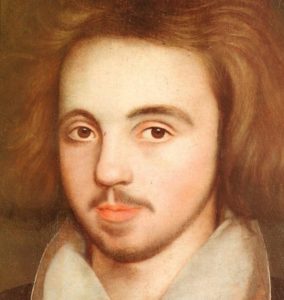Dana Gower has been a follower of ShakespeareGeek for years, mostly via Facebook, and often sends me interesting links and curiosities. He runs his own page ShaksperFauxFest. Ask him his thoughts on Sonnet 136 if you get the chance. When he sent me his thoughts on an interesting Mercutio/Marlowe connection I offered him the opportunity for a guest post!
Did William Shakespeare publicly accuse Queen Elizabeth and her advisers of ordering the murder of Christopher Marlowe?
On May 30, 1593, Marlowe died after being stabbed at a Deptford inn. The London theaters were closed at the time due to the plague, but shortly after they reopened, Shakespeare presented a new play. Not everyone may agree, but it appears fairly certain that “Romeo and Juliet” was presented in 1594 (not 1597), and that the character of Mercutio was included in order to allow Shakespeare to mention Marlowe’s death.

There are a number of hints throughout the play tying Marlowe to Mercutio, but there is one stunning phrase that makes Shakespeare’s intent clear. It tends to be overlooked by, and can be confusing to, modern audiences, but it would have been clear to many of Shakerspeare’s own. Early in the play, Tybalt, the character who will kill Mercutio, has been called “more than the prince of cats” and the “king of cats.” The reference is to a series of animal tales, still popular in Shakespeare’s time, that included a cat variously named Tybalt, Tybert, or Tibert. Shakespeare clearly has named Tybalt as the cat. As he dies, Mercutio calls out, “Zounds, a dog, a rat, a mouse, a cat, to scratch a man to death.” That phrase is a reference to a piece of doggerel from the time of King Richard III, which would have been well-known to Shakespeare, writer of the English history plays, and to many in his audience:
“The Rat, the Cat, and Lovell, our Dog
Rule over England under the Hog.”
The Hog, of course, was Richard, whose personal badge was the white boar. The Rat, the Cat, and Lovell, the Dog, represent Richard’s closest advisers. The Rat is Sir Richard Ratcliffe. The Cat is William Catesby. A descendent of Catesby’s, Robert Catesby, would one day become a leader in the Gunpowder Plot against King James the First and members of Parliament. Francis Lovell, First Viscount Lovell, was a longtime supporter and close friend of Richard’s. His heraldic device was the white wolf, but the poem probably was referring to him as Richard’s lapdog. These men were the closest of Richard’s inner circle.
If you move these positions up to Shakespeare’s own time, you have Queen Elizabeth and her own inner circle of advisers, with Queen Elizabeth taking the part of the Mouse. I don’t know which of her advisers were meant to take the place of the Dog, the Cat, and the Rat, but it really doesn’t matter. By having Mercutio label Tybalt, his killer, as the Cat, Shakespeare clearly is laying Marlowe’s death squarely at their feet.
Shakespeare’s response to Marlowe’s death, an act of incredible courage, had no immediate effect. Marlowe, of course, was still dead. None of the men said to have been with him at the time were ever held to account, and no one else dared, as far as I can tell, to publicly tie his death to the queen. Still, Shakespeare had made his point: “We are watching.”
I’ve borrowed most of this from a very short book I just self-published on Amazon, “Remembering Mercutio: Some thoughts on Michael Hastings’ death.” This is the only part about Shakespeare, but I couldn’t resist the opportunity to mention, “Zounds, a dog, a rat, a mouse, a cat…” The connection between Marlowe and Mercutio is well-known, but I think the meaning of that line has been forgotten. I’d love to hear what everybody thinks.
